Last Updated on January 19, 2024 by Greg Gillson
Do you have a hummingbird feeder set up in your yard? Yes? Great! Now set up another!
Wait. You can have 2 hummingbird feeders? Why, yes, yes you can! And more.
You can get more hummingbirds by putting up more hummingbird feeders!
There are other reasons to have multiple feeders, too.
What other reasons are there to have more than one hummingbird feeder? We’ll answer that question first. Then we’ll answer another question you may have, namely: How far apart should you place additional feeders?
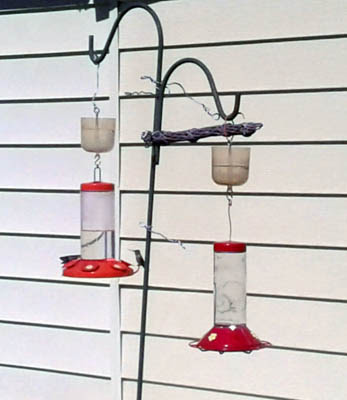 |
| My neighbor has two hummingbird feeders… and LOT’S of hummingbirds! There were 6 or 7 birds buzzing around when I snapped this picture. |
Why have two hummingbird feeders?
Recently I set up a hummingbird feeder after several months of not feeding hummingbirds. I don’t remember why I stopped feeding hummingbirds, but I did.
Oh, that reminds me. My hummingbird feeder is empty again and I have to make more nectar. Thinking about it, I may have stopped feeding hummingbirds because we ran out of sugar. We aren’t bakers, so don’t ever use sugar for anything except making hummingbird nectar. Could that be it? What a poor excuse for not enjoying the daily antics of these wonderfully energetic creatures!
So, right now I only have one hummingbird feeder… and that, apparently, empty. (sigh) But I have discovered 3 reasons to have two or more hummingbird feeders. You may think of other reasons. If so, please leave your reasons in the comments section….
… Okay, I’m back. Yes, I felt so guilty that I went out and took down my (mostly) empty hummingbird feeder.
I brought it in and washed it thoroughly, using dish washing liquid and an appropriate sized bottle brush. Then I stirred together thoroughly 1 cup of granulated sugar and 4 cups of warm tap water in a sauce pan. I refilled the feeder using a funnel. Extra hummingbird nectar went into two plastic water bottles marked “HB” and placed them in the fridge. It only took me 12 minutes.
[See my article on making your own hummingbird nectar: “Recipe: Hummingbird food–Steal your neighbor’s hummingbirds!“]
The bully hummingbird
Have you heard about the “bully hummingbird”?
Some people who feed hummingbirds become upset that one dominant bird takes over the feeder and drives off any other hummingbirds that try to drink. Hummingbirds are no different than chickens, evidently. There is always a “pecking order” of dominant and submissive birds. “One ring (hummingbird) to rule them all.”
This territoriality is perfectly normal. But you’d rather have a dozen hummingbirds all sharing peacefully, wouldn’t you?
Sorry. That’s not going to happen. But offering more than one hummingbird feeder makes it easier for the submissive birds to get in and get a drink. How so?
Having more than one feeder offers more opportunities for hummingbirds to get a drink. The hummingbirds notice the extra feeders and are more determined to get some for themselves. While the master chases off one hummingbird, another can get in for a few seconds of ambrosia!
I see that my dominant “bully” hummingbird is back at his perch on the giant bird-of-paradise, keeping vigil–taking on all comers.
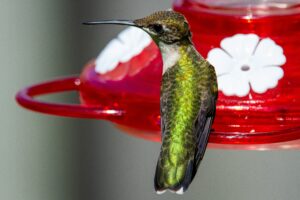
Get more hummingbirds!
Hummingbirds don’t take long to learn what a hummingbird feeder is. They soon learn that each feeder means additional feeding ports. More food!
If you live in a location where hummingbirds are numerous, you can have a surprising number of hummingbirds coming to drink. More feeders; more hummingbirds!
By mid summer (July) the adult male hummingbirds have already migrated southward. In the West, adult males follow the mountain ridges south into Mexico, feeding on montane flower nectar.
But the birds-of-the-year often stick around their breeding areas into early October. Younger birds seem a bit more agreeable to feed together, without the bully adult males around.
On the Gulf Coast fall concentrations of Ruby-throated Hummingbirds can be amazing.
In southern California (where I live) Anna’s Hummingbirds are very common year-round residents.
But other species migrate through. Some breed in spring nearby in the oak hills (Black-chinned Hummingbird) or the desert beyond (Costa’s Hummingbirds) or along the beach (Allen’s Hummingbird). They winter elsewhere, and visit during migration. And Rufous Hummingbirds pass through in spring and fall. I may see them stop briefly at my feeder on their way between Mexico and Alaska, or return.
The more feeders you have, the more hummingbird activity you have.
Those migrants I mentioned are very good at spotting other hummingbirds feeding. These migrants, though smaller, are often more pugnacious than the large resident Anna’s and push right in to the feeder!
Never run out of feeder nectar
If I would have had multiple hummingbird feeders I wouldn’t have run completely out of hummingbird food.
You see, I would fill them at different times or at different levels. That way my second (or third!) feeder would still be half full when the first feeder ran out of liquid.
 |
| My hummingbird feeder is all filled up and ready to go. Now all I need is ANOTHER hummingbird feeder! |
Of course, if I don’t go to the store to buy more sugar I will run out of nectar. More feeders mean more food gets eaten.
On the other hand, I do want my feeders to empty completely in 3 days. The hot California sun can cause the sugar-mixture to grow algae or attract ants.
So I want to clean my feeders every 3 days, or so, to keep them clean and safe for the hummingbirds to drink from. That means that I choose a smaller feeder and don’t always fill it completely full.
With two or more feeders I can rotate through. I would allow one feeder to go completely empty and then take it down and clean it. Other feeders would still be providing the precious calories the hummingbirds need.
How far apart should hummingbird feeders be placed from each other?
When you have two hummingbird feeders, or more, a question arises. To make it harder for the bully hummingbird to take over, do you hang a second hummingbird feeder together with the first feeder or perhaps around the corner, out of a direct line-of-sight?
The consensus seems to be: “it depends.”
Are hummingbird numbers, generally, in your neighborhood low? Then having a second hummingbird feeder widely spaced, perhaps “hidden” from the first, may work best. Your dominant hummingbird will guard one feeder. Other birds may feed from the second feeder.
Are there several hummingbirds visiting your yard? Then what will happen is that the second-most-dominant hummingbird will take over the second feeder. Then you’ll have two feeders, both with their own personal “bully” hummingbird, keeping all other birds away.
With more hummingbirds, and more feeders, it becomes harder for one bird to take over. Placing multiple hummingbird feeders together will provide a buzz of activity and chasing. But often several hummingbirds will tolerate each other and feed at once, albeit briefly.
Why not do both? Put a couple of feeders together on one side of the house. Put another around the corner. Your neighbors may think you a bit eccentric, but that’s not necessarily a bad thing, is it?
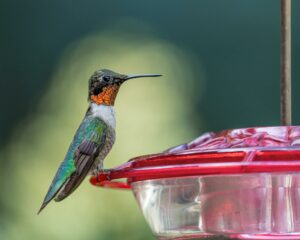
Wrapping Up
Hummingbirds can be fiercely territorial and this can be a reason for the need for more than one feeder. These tiny feathered jewels, despite their delicate appearance, defend their feeding grounds and breeding areas with surprising zeal. Here’s why:
Hummingbirds rely on nectar for food, and flowers only produce so much. Defending a territory ensures access to a reliable source of this crucial resource, especially during competition for food. This includes backyard feeders.
Territorial behavior is deeply ingrained in many hummingbird species. It’s thought to be an evolutionary adaptation that helps them survive and reproduce in competitive environments.
They chase intruding hummingbirds away from their territory, often with high-pitched chirps and dive-bombing attacks. Males puff out their throats and feathers, raising their chins and spreading their tails to appear larger and intimidate rivals.
Dominant hummingbirds occupy the best feeding spots and chase away others, ensuring they get the most nectar.
Frequently Asked Questions
Which feeder do hummingbirds like best?
Hummingbirds are picky diners, so the “best” feeder depends on several factors like the bird species, their preferences, and your local climate. However, here are some general tips to choose a hummingbird feeder they’ll adore:
- Dish feeders: Simple open trays are easy to clean and fill, offering a clear view of the nectar for hummingbirds. These are great choices for beginners or areas with minimal bee problems.
- Bottle feeders: These inverted bottles with feeding ports provide a continuous nectar flow, attracting various hummingbird species. However, they require regular cleaning to prevent mold growth.
- Saucer feeders: Similar to dish feeders, saucer feeders have shallow reservoirs and multiple ports, but the covered design minimizes bee and insect intrusion. They’re also easy to clean and refill.
Are glass hummingbird feeders better than plastic?
Whether glass hummingbird feeders are better than plastic ones depends on a few factors and your personal preferences. Here’s a breakdown:
Glass feeders are aesthetically pleasing, often bright red which attracts hummingbirds more readily. They offer a clear view of the nectar level, making monitoring and refilling easier. It can also be more durable than plastic, especially if it’s thick and high quality. It’s less prone to warping, cracking, or fading over time.
Smooth glass surfaces are easier to clean and sanitize than textured plastic, potentially reducing the risk of bacteria growth and unlike some plastic feeders, glass avoids potential leaching of harmful chemicals into the nectar.
However, glass can break, especially if dropped or exposed to harsh weather conditions. This can be a safety concern for birds and humans. They are also heavier than plastic, making them a bit more challenging to hang and move around.
Related Article: Where do hummingbirds migrate to in spring and fall?






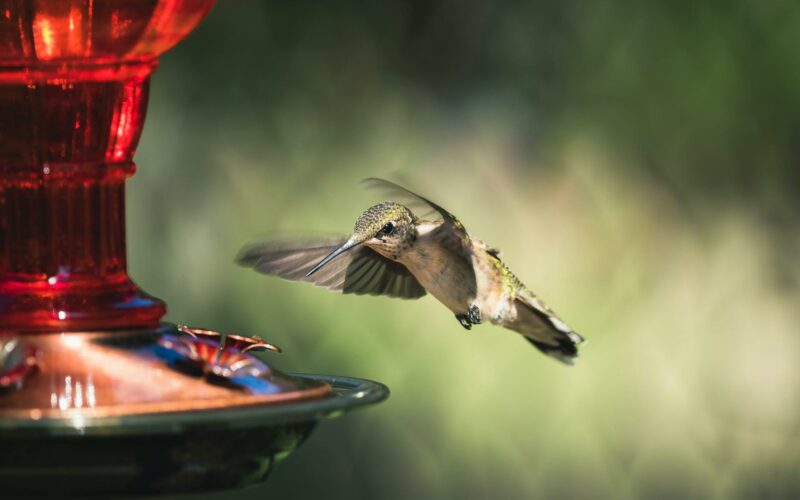
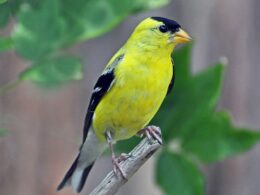

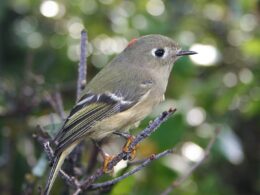
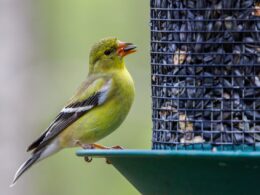
Hi, I'm not sure if you can specify by size or region? We have a small nest in an old wreath with very small birds, gray/tan with red on the top of their heads, and more round body than tail. Not sure if you only cover parts of the U.S.? (We're in Maine.) But thank you for your site – I'm off to a good start! – Karen J.
Karen,
I'm so glad my articles helped you.
I do know what bird is nesting on your wreath. Your description is great! It is a House Finch.
Please see my article:
https://whatbirdsareinmybackyard.com/2020/04/where-do-house-finches-like-to-nest.html
Gosh…I need help ..I live in the woods…300+ acres… 3 feeders .m1 front porch 2 back…twice a day beautiful? Creatures. Drain them…I'm scared of them…dive bomb me! I don't know what I'm doing wrong. No lie 30 or more…
More than 30 hummingbirds? Am I understanding that right?
Well, no wonder they scare you when they fly around chasing each other!
They really won't hurt you. They are as light as fluff. If they accidentally hit you they may crumple.
Sounds like you may need to move the feeders farther from your porch, through.
I suggest a shepherds hook out in the yard.
I currently have 3 hummingbird feeder’s out ( 1 hanging in front of kitchen window WS, 1 on front porch in front of Picture window ES, and 1 hanging in Pine tree NS . It Is so entertaining to watch them fly over the roof back n forth trying to beat the Bully’s! Lol and when they are out of nectar at the kitchen they’ll perch at the feeder then buzz up & fly directly up to the window like “ Hey Lady we’re outta nectar & starving “ Fill Our Feeder!” Lol and when I’m out taking it down & putting it back up They’ll BUZZ right by my face !! They are so Funny 😂